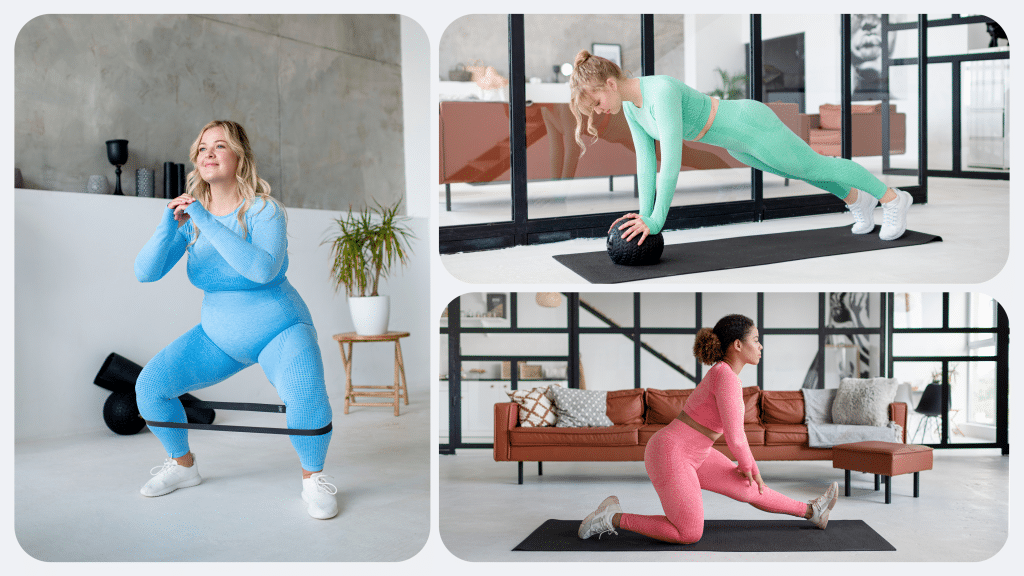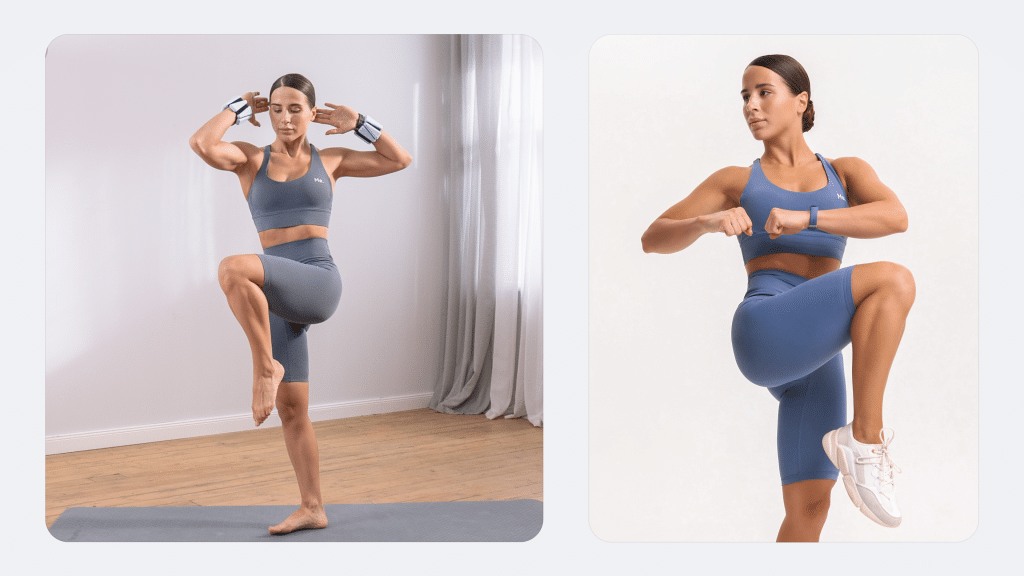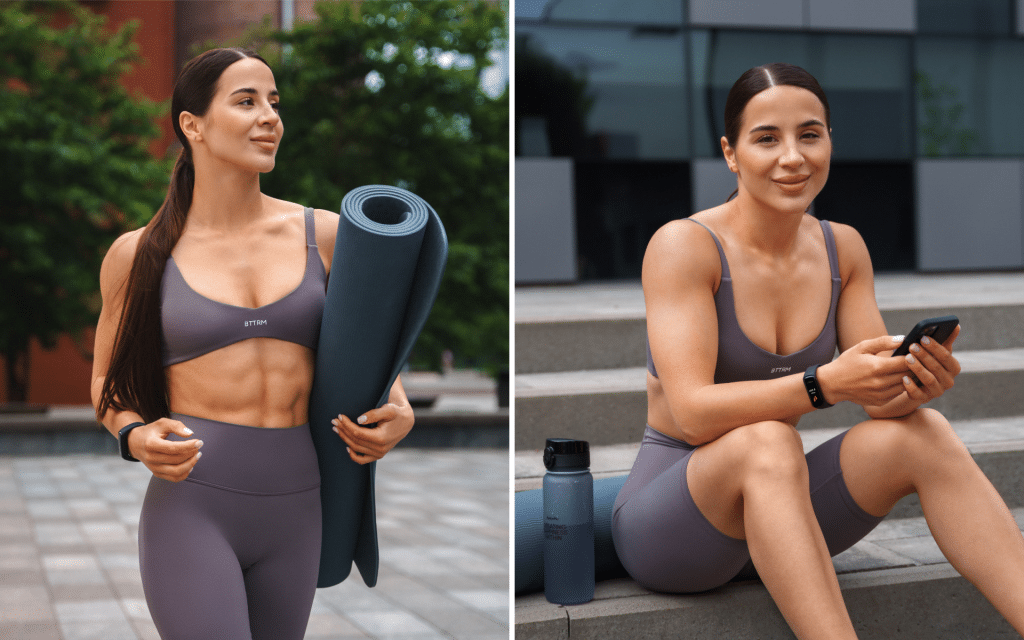Caring for your body after having a baby is essential for your health and self-esteem. No new mother wants a saggy belly, but sometimes it feels like that’s all you’re left with after pregnancy and childbirth.
The good news is that you can do plenty of things to get your body back into shape, including core exercises postpartum. A common misconception is that abs are best worked with crunches and sit-ups, but this isn’t necessarily true.
When it comes to postpartum core exercises, it’s important to focus on rebuilding the deep abdominal muscles that support your spine. These are the muscles that were stretched and weakened during pregnancy, and they need to be strengthened to provide the stability your body needs.
In this article, we will discuss why a core postpartum workout plan is important for new moms and give you some specific exercises that can help you tighten your midsection after pregnancy.
Why Is My Core So Weak After Having a Baby?
Having a weaker core is normal after delivery. In fact, in one study published in 2019 in the Medicine & Science in Sports & Exercise journal, researchers found that postpartum women – regardless of whether they had Cesarean or vaginal deliveries – had weak trunk (aka core) muscles 26 weeks (close to 6 months) after giving birth (1).
So don’t feel alone and neither should you believe the notion that women can and should “snap back” into shape after having a baby. It simply doesn’t work like that and it sets unrealistic expectations.
So what causes this weakness?
- The first reason would be the strain caused by the belly throughout pregnancy. Your core is made up of a variety of muscles – not just the rectus abdominis (the 6-pack muscle).
Muscles are elastic and as the belly grows, it stretches said muscles. However, just with anything elastic, too much pressure – like the weight of a baby – can ruin/weaken the elasticity. Once you have delivered the baby, your muscles will need time to, hopefully, naturally regain the elasticity and go back to normal. Try to remember that the muscles were stretched for 9 months so do not expect them to snap back to their original strength quickly. Time and patience are needed for this.
- The second reason is a separation of the six-pack muscle (2). If you take a look at the belly of a very fit person, you may realize that the rectus abdominis is separated by a line. This line is known as the linea alba.
As your baby grows inside of you, they put pressure on this line which slowly thins it out. If the pressure is great enough, the linea alba can become incredibly thin to the point where it eventually breaks and separates (3).
As with your muscles, this line is elastic and can usually put itself back after delivery. However, if it’s overstretched, it can become too weak to put itself back together after delivery. Research has shown that some women are left to deal with this issue for up to six, eight, or even 12 months after delivery (4, 5).
How Do I Know If I Have a Weak Core After Pregnancy?
There are several signs that may indicate you have a weak core, including (1):
- Lower-back pain
- Poor posture
- Difficulty standing up from a sitting position without using your hands
- Difficulty walking or running without pain or discomfort
- Leaking urine when coughing, sneezing, laughing, or performing various activities (stress incontinence)
If you’re experiencing any of these symptoms, it’s a good idea to consult a physical therapist or doctor who can help you identify the root cause and create a plan to strengthen your core.
BetterMe: Health Coaching app helps you achieve your body goals with ease and efficiency by helping to choose proper meal plans and effective workouts. Start using our app and you will see good results in a short time.
How Do I Know If I Have Separated Abdominal Muscles?
As we already mentioned, this condition occurs when the tissue that holds the six-pack muscle together is stretched beyond capacity and breaks. Women who complain about this issue often complain about urinary stress incontinence and back pain (3). As this issue impacts trunk and pelvic stabilization, it could lead to poor posture (6).
If you’re not sure whether or not you have an issue with separated abdominal muscles, there are a few things you can do to check.
- First, lie down on your back with your knees bent and feet flat on the floor. Place your fingers just above your belly button and press gently. If you can feel a gap between the muscles, you likely have this condition.
- Another way to check is to sit up tall and place your fingers on either side of your navel. As you exhale, try to bring your navel toward your spine. If you can feel a gap between the muscles, you likely have separated abdominals.
Remember that while at-home tests can help you realize you’re suffering from a specific condition, it’s always best to consult a doctor or physical therapist to confirm if your suspicions are right.
Read more: A Postpartum Workout Plan for Every Mom: Your Guide to Fitness After Baby
How Do I Strengthen My Core Postpartum?
According to research and experts, exercise is one of the many ways postpartum women can attempt to strengthen their weak core muscles. Strengthening these muscles and tissues isn’t only for cosmetic or aesthetic purposes and could also help put a stop to the many problems that come with a weaker core (3, 6, 7).
Here are some of the best postpartum core exercises that may help you strengthen your core after pregnancy:
-
Transverse Abdominal Breathing
According to research, diaphragmatic breathing (aka belly breathing or abdominal breathing) is great for core strengthening and stabilization.
A paper published in 2012 referred to diaphragmatic breathing as ‘the foundation of core stability’(8) and a more recent study published in 2023 stated that these types of breathing exercises increase the activity of the deep trunk muscles and may also help in reducing lower-back pain (9).
Transverse abdominal breathing is one such exercise. This exercise targets the transverse abdominis, the deepest layer of abdominal muscle. It also teaches you how to posteriorly tilt your pelvis, which is an important part of engaging your core muscles.
Furthermore, breathwork, specifically diaphragmatic breathing is associated with reduced stress (10, 11) which is important for new moms who are often dealing with a lot of stress and anxiety.
To do transverse abdominal breathing:
- Lie on your back with your knees bent and your feet flat on the floor.
- Place one hand on your belly and the other on your chest.
- As you inhale, focus on drawing your belly toward your spine. You should feel your hand move out as your belly expands.
- As you exhale, focus on drawing your navel toward your spine. You should feel your hand move in as your belly contracts.
- Count to 10 as you inhale and exhale.
- Repeat for 10 breaths.
-
Pelvic Bridge
In yoga, the bridge or Setu Bandha Sarvangasana is a classic pose that helps strengthen the muscles in the back, buttocks, and legs. It also provides a gentle stretch for the chest and shoulders.
This exercise is often recommended for women who are dealing with back pain. This is because it helps strengthen the muscles that support the spine. The pelvic bridge is also a great way to engage the deep abdominal muscles.
To do the pelvic bridge:
- Lie on your back with your knees bent and your feet flat on the floor.
- Place your arms down at your sides.
- As you inhale, lift your hips off the floor and press them toward the ceiling. Your body should form a straight line from your knees to your shoulders.
- Hold the position for 5 seconds, then slowly lower your hips back to the starting position.
- Repeat it 10 times.
-
Lying Bent Knee Pulls
This is a great exercise for postpartum women who want to improve their core strength and hopefully strengthen their separated 6-pack muscles, particularly the lower abs. As it works the deep transverse abdominal muscles, lower abs, and hips, it’s a fantastic workout to add to your list.
To perform lying bent knee pulls:
- Lie on your back with your knees bent and your feet flat on the floor.
- Place your arms down at your sides.
- As you inhale, press your lower back into the floor and lift your knees toward your chest.
- Place your hands on your knees and gently pull them toward your chest as you exhale.
- Hold the position for 5 seconds, then slowly lower your legs back to the starting position.
- Repeat 10 times.
-
Bent Knee Marching
This is a variation of the bent knee pull exercise and it’s a great way to engage the muscles in the hips and thighs.
To do bent knee marching:
- Lie on your back with your knees bent at a 90-degree angle.
- Place your hands on your abdomen, just below your navel.
- Alternate tapping one toe down to the floor, then the other.
- As you tap your toes down, press your lower back into the floor and tighten your abdominal muscles.
- Continue for 30 seconds.
-
Heel Slides
Heel slides are a great way to stretch the hamstrings and lower back. They also help engage the deep abdominal muscles.
To perform heel slides:
- Lie on your back with your knees bent and your feet flat on the floor.
- Place your hands by your sides.
- As you inhale, slide your right heel away from your butt until your leg is straight.
- As you exhale, press your heel back toward your butt.
- Alternate legs and continue to perform 10 repetitions on each side.
-
Leg Extensions
Leg extensions recruit the transverse abdominal muscles and help engage the deep abdominal muscles. They also stretch the hamstrings and lower back.
To do leg extensions:
- Lie on your back with your knees bent at a 90-degree angle and your feet flat on the floor.
- Place your hands by your sides.
- As you inhale, press your lower back into the floor and raise your right leg up toward the ceiling.
- As you exhale, lower your leg back to the starting position.
- Alternate legs and continue to do 10 repetitions on each side.
-
Pilates Scissors
Pilates scissors is a great exercise for postpartum women who are dealing with weak core muscles. This is primarily a core muscles workout that helps target the lower abs, transverse abdominis, and obliques. The exercise also works your hamstrings, calves, and hip flexors, which is fantastic for improved flexibility and mobility
- Lie on your back with your knees bent and your feet flat on the floor.
- Place your right hand on your abdomen, just below your navel.
- As you inhale, press your lower back into the floor and lift your head and shoulders off the ground.
- As you exhale, twist your torso to the right and reach your left hand toward your right knee.
- Hold the position for 5 seconds, then slowly return to the starting position.
- Repeat on the other side.
What Are Some Core Exercises to Avoid Postpartum?
Sit-ups and crunches are two core workouts that many people turn to when they hope to strengthen these muscles or reduce belly fat. However, as a postpartum woman, these two workouts and their variations are among the worst exercises you can attempt.
Such workouts cause the abdomen to bulge forward, which can make an issue such as the separation of abdominal muscles worse. Aside from all variations of sit-ups and crunches, postpartum women are also advised to avoid doing traditional planks or push-ups, exercises that require twisting the spine and lifting anything heavy.
Should you consider running postpartum? Explore this article to better understand if and when new mothers should consider running as an exercise.
Which Exercise Is Best for Postpartum Belly?
No single exercise stands above the rest as the ‘best’ postpartum belly workout. All the above-listed workouts can help strengthen your core muscles.
You should also make a point of speaking to your doctor so they can advise you on the best exercises for you based on your health and any other specific needs.
If you’re curious about the best way to lose postpartum belly fat, check out this article to learn the safest way to approach this issue.
When Can I Start Core Exercises After Birth?
Most women can start doing core exercises 6 weeks after giving birth, as long as they’ve been cleared to do so by their doctor. Note that this timeline is dependent on various factors such as type of delivery, any complications, and individual recovery (12).
If you had a c-section, you may need to wait a little bit longer before you start any abdominal exercises. If you’re not sure whether or not you’re ready to start exercising, it’s best to check with your doctor first.
Read more: Quad-Focused Exercises: Build Stronger, More Defined Legs
Safety Precautions for Postpartum Workout
Here are a few safety precautions you should keep in mind when doing any type of postpartum workout:
-
Get the Go-Ahead from Your Doctor
Always check with your doctor before you start any type of exercise program, particularly if you’ve had a c-section.
-
Start Slow
Don’t try to do too much too soon. Start with just a few minutes of exercise each day and gradually increase the duration and intensity as you feel more comfortable.
-
Control Your Breath and Movement
Breathing correctly is essential for any type of exercise, but it’s particularly important when you’re doing core exercises. Make sure to exhale as you engage your abdominal muscles and inhale as you release them.
Also, make sure to move slowly and controlled throughout the entire exercise. Moving too quickly or using jerky motions can put unnecessary strain on your healing muscles and connective tissue.
If you wish to free yourself from all the extra pounds that have been weighing you down for way too long, start using the BetterMe: Health Coaching app and overhaul your entire life!
-
Stop If You Feel Pain
Postpartum bodies are different than they were before pregnancy. You may find that certain exercises you used to do are now too difficult or cause you pain. If you feel any painful discomfort during an exercise, stop immediately and consult your doctor.
-
Listen to Your Body
It’s generally important to listen to your body and not push yourself too hard. If you’re feeling exhausted, take a break or end your workout early.
It’s also important to drink plenty of water and eat a healthy diet when you’re exercising. This will help your body recover more quickly and reduce injury risk.
How Long Does It Take for Your Core to Heal After Pregnancy?
The answer to this question is a complicated one. As every woman’s body is different, we can’t give you an umbrella answer for this. Some women can heal and regain core strength and functionality in just a few weeks, while others may need several months and up to a year to heal and regain their pre-baby strength and functionality.
You shouldn’t attempt traditional planks during the postpartum period as they may cause abdominal bulging, which can worsen the issue of separated abdominal muscles. This can be due to multiple reasons. You may have excess fat, separated abdominal muscles which causes a ‘belly pooch’ and makes the belly appear big, or be dealing with excess skin. Consult your doctor to find the root cause of the issue and figure out the best ways to deal with it. While sources state how soon you should wear a belly wrap – some say that you can start as soon as 2 weeks after delivery – there is no clear information on when it’s considered too late to wear one. Consult your doctor regarding when it’s best to start wearing one and if you’re already past the day when the wrap would be effective. It’s generally advisable to wait until the 6-week mark after a vaginal birth before you engage in exercise (12). If you’re thinking about starting before this period is up, please speak to your doctor to avoid any complications.Frequently Asked Questions
Can you do planks postpartum?
Why is my belly so big 4 months postpartum?
When is it too late to wear a postpartum belly wrap?
When can I do squats after giving birth?
The Bottom Line
Doing core exercises is a great way to help tighten your midsection after pregnancy. Remember that it’s important to start slowly and gradually increase the intensity of your workouts as you become stronger. If you have any questions or concerns about starting an exercise program, make sure to talk to your doctor before you start.
DISCLAIMER:
This article is intended for general informational purposes only and does not serve to address individual circumstances. It is not a substitute for professional advice or help and should not be relied on for making any kind of decision-making. Any action taken as a direct or indirect result of the information in this article is entirely at your own risk and is your sole responsibility.
BetterMe, its content staff, and its medical advisors accept no responsibility for inaccuracies, errors, misstatements, inconsistencies, or omissions and specifically disclaim any liability, loss or risk, personal, professional or otherwise, which may be incurred as a consequence, directly or indirectly, of the use and/or application of any content.
You should always seek the advice of your physician or other qualified health provider with any questions you may have regarding a medical condition or your specific situation. Never disregard professional medical advice or delay seeking it because of BetterMe content. If you suspect or think you may have a medical emergency, call your doctor.
SOURCES:
- Impaired Trunk Flexor Strength, Fatigability, and Steadiness in Postpartum Women (2019, pmc.ncbi.nlm.nih.gov)
- Your post-pregnancy body (2023, nhs.uk)
- Diastasis Recti Rehabilitation (2023, ncbi.nlm.nih.gov)
- Primiparous women’s knowledge of diastasis recti abdominis, concerns about abdominal appearance, treatments, and perceived abdominal muscle strength 6–8 months postpartum. A cross sectional comparison study (2022, bmcwomenshealth.biomedcentral.com)
- Diastasis recti abdominis during pregnancy and 12 months after childbirth: prevalence, risk factors and report of lumbopelvic pain (2009, bjsm.bmj.com)
- Diastasis recti abdominis — a review of treatment methods (2018, journals.viamedica.pl)
- Efficacy of deep core stability exercise program in postpartum women with diastasis recti abdominis: a randomised controlled trial (2019, pmc.ncbi.nlm.nih.gov)
- Diaphragmatic Breathing: The Foundation of Core Stability (2012, researchgate.net)
- Diaphragmatic breathing exercises in recovery from fatigue-induced changes in spinal mobility and postural stability: a study protocol (2023, pmc.ncbi.nlm.nih.gov)
- Effectiveness of diaphragmatic breathing for reducing physiological and psychological stress in adults: a quantitative systematic review (2019, pubmed.ncbi.nlm.nih.gov)
- Effect of breathwork on stress and mental health: A meta-analysis of randomised-controlled trials (2023, nature.com)
- Maximizing Recovery in the Postpartum Period: A Timeline for Rehabilitation from Pregnancy through Return to Sport (2022, pmc.ncbi.nlm.nih.gov)













